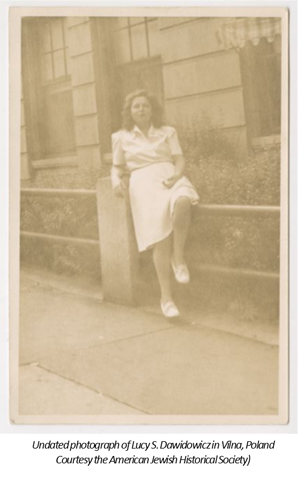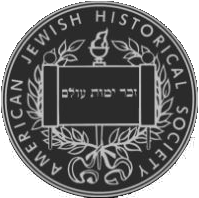On International Women’s Day in 2020, how are we to honor an anti-feminist American Jewish woman who played such a vital role in the construction of Holocaust consciousness in the postwar years, and helped to rescue so many of the cultural treasures that are now housed at the Center for Jewish History?

On August 28, 1968, Berlin-born historian and Reform rabbi, Michael A. Meyer, wrote a letter to Lucy S. Dawidowicz, author of The Golden Tradition: Jewish Life in Eastern Europe (1967), about her article, “Being a Woman in Shul,” published in July of that year. In her characteristically unapologetic style, Dawidowicz announced her support for the gender divide in traditional Jewish prayer at a historical moment when second-wave feminists advocated overthrowing the patriarchy to create gender equality. Jewish feminists were demanding more of a role in public worship, too. Not so Dawidowicz, who declared, “To my astonishment—for I thought myself modern—I like the partition.” She went on to criticize the celebration of the festival of Shavuot at a Reconstructionist synagogue, when women danced with the Torah scrolls. The “dry-as-dust service” left her cold, she wrote, but what really bothered her was “the feminist spirit” that informed it. Women called up as the Torah’s bride (Kallat Torah) were “insensible to the festival’s symbolism.”
In Meyer’s letter, which is held in the Dawidowicz Papers of the American Jewish Historical Society, he wrote, “I very much enjoyed an article you wrote for the July issue of Commentary, ‘On Being a Woman in Shul.’ It reminded me somewhat of a piece I had done for the HUC student magazine, variant[,] back in 1961 when I was a student here. It seemed to me you might be interested in how someone who grew up entirely in the Reform movement feels on the subject. I’m not sure I would write it the same way today, but I still subscribe to its main points.”1
Dawidowicz wrote back to Meyer a few weeks later, “What an extraordinary coincidence–your piece and mine. I was utterly fascinated with your article, and I am grateful to you that you sent it to me. To paraphrase W. C. Fields, not everyone connected with Reform is all bad!”2
This brief exchange tells us legions about Lucy S. Dawidowicz (1915-1990), a pioneering historian in the field that is now called Holocaust Studies, who journeyed from the political left to the political right in the course of her life. Reared in a Yiddish-speaking East European Jewish immigrant home, Dawidowicz was briefly a communist in her youth. She soon became a die-hard FDR Democrat, and then, in the early 1960s, moved to the right, aligning herself later in the decade with the group of Jewish New York intellectuals who played a decisive role in the emergence of neoconservatism.
On her rightward trajectory, Dawidowicz also began to challenge many of the deeply held commitments of her secular, Yiddishist peers. She despaired of the sufficiency of the Yiddish language to ensure a Jewish future, she questioned whether American Jews had gone too far in their discomfort with championing the need for Jewish group rights in arguments about the wall between Church and State, and she began a slow, if incomplete rapprochement with normative Jewish practice. All of these changes, atop her temperamental suspicion of anti-intellectualism, generational mistrust of the New Left’s politics, and personal investment in privacy, informed her dismissal of 1970s feminism and the feminization of Jewish ritual.
“Litvish” by choice, Dawidowicz viewed feminism much the way she did other social movements of the late 1960s: as a kind of special group pleading, antithetical to an older conception of American liberalism based on individual, as opposed to collective, rights. She wanted to be taken seriously as an intellectual, not as a female intellectual, and believed her achievements were based on merit, like those of her male peers. Dawidowicz dismissed the charge that she and other Jewish women were victims of systemic patriarchal discrimination in which Jewish men were implicated. She rejected the argument that women’s culture was distinct and had different ends than men’s and therefore deserved a sphere of its own. Culture, in her view, had to be based on creative values, not merely on resentments.
Dawidowicz’s anti-feminism set her apart from some of her female friends. In 1985, Labor Zionist Marie Syrkin addressed the tension between the individualism of feminism and the collectivism of Jewish national movements in an essay, “Does Feminism Clash with Jewish National Need?;” she equivocated, concluding that “Anatomy obviously affects destiny, though it need not determine the outcome,” but that some professional achievement will come through “the loss of a vital aspect of womanhood.” Dawidowicz’s rejoinder concluded that second-wave feminism clashed with Jewish national needs because it bore all the signs of the exclusivist vanguardism of earlier revolutionary movements. Feminists were willing to run rough shod over the Jewish common good in order to realize single-minded, separatist goals. Pointedly, she wrote to Joel Carmichael, Midstream’s editor, “Feminism is actually intellectually tiresome, since it is utterly without ideas. It’s really only a politics of resentment. I wrote this piece only to show my respect for Marie.”3 For Dawidowicz, sex was a private matter, and she rejected second-wave feminism’s assumption that male and female needs were inherently antagonist. The essential binary for Dawidowicz was “Jew” and “non-Jew.” Her primary loyalty was to the Jewish people, not to her sex.4

Nonetheless, in “On Being a Woman in Shul,” she admitted her loneliness in the women’s section. In her ideal world, Dawidowicz would be able to share the women’s gallery with a group of like-minded, literate women.5 Moreover, despite her rejection of the feminization of Jewish ritual and of feminism itself, Dawidowicz was aware of her singular status as a female Jewish public intellectual who was often the only woman present at scholarly and board meetings, or on the roster for public lectures. Speaking with the alumni of Yeshiva University’s rabbinical school in 1971, she initially began her remarks (later excised), by warning the “gentlemen” in her audience that “you may be in trouble for talking overmuch with women.”6
So, on International Women’s Day in 2020, how are we to honor an anti-feminist American Jewish woman who played such a vital role in the construction of Holocaust consciousness in the postwar years, and helped to rescue so many of the cultural treasures that are now housed at the Center for Jewish History? By doing what good historians do: being “there” now, in her place and time, and giving voice to her views.
Dr. Nancy Sinkoff’s book From Left to Right: Lucy S. Dawidowicz, the New York Intellectuals, and the Politics of Jewish History was released in March, 2020.
1Michael A. Meyer, Lucy S. Dawidowicz, August 28, 1968, Dawidowicz Papers, box 77, folder 11. See, too, “On the Role of the Sexes in Modern Judaism,” variant, 1:1 (January 1969): 43-47.
2 Lucy S. Dawidowicz to Michael A. Meyer, September 9, 1968, Dawidowicz Papers, box 77, folder 11.
3Lucy S. Dawidowicz to Joel Carmichael, July 28, 1985. Dawidowicz Papers, box 78, folder 9 and Lucy S. Dawidowicz, “Symposium: Does Judaism Need Feminism?” Midstream, April 1986, 39–40. See, too, Lucy S. Dawidowicz to Edward Alexander, July 4, 1986. Dawidowicz Papers, box 79, folder 4b.
4Marie Syrkin, “Does Feminism Clash with Jewish National Need?” Midstream, June-July 1985, 8–12 and Lucy S. Dawidowicz, “Symposium: Does Judaism Need Feminism?” Midstream, April 1986, 39-40.
5Lucy S. Dawidowicz, “On Being a Woman in Shul,” 74.
6“Shaping of Interfaith Relations,” lecture to the rabbinic alumni of Yeshiva University, March 18, 1971. Dawidowicz Papers, box 70, folder 3.

